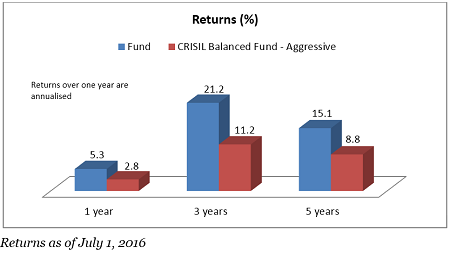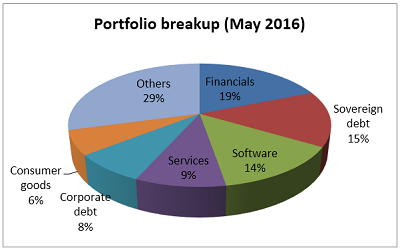Balanced funds are suitable for moderate-risk equity investors, or first-timers who want to test the equity waters. SBI Magnum Balanced is one such fund that has been moving up the ranks in its category. In the one, three, and five year periods, the fund’s returns have been 3-10 percentage points above its benchmark – the CRISIL Balanced Fund–Aggressive index. Its performance has been propelled by better stock picking, nimble switching of stocks in the mid-cap space, and a fund manager change in 2012.
SBI Magnum Balanced’s stellar run has partly come from taking on higher risks in both debt and equity, especially when compared to its peers. These high-risk bets have paid off handsomely in the form of a sustained mid-and-small cap rally and better yields from lower-rated corporate debt.
Risk pays off
The fund’s equity allocation is around 68-70 per cent, while the rest of its portfolio is in debt. Its higher debt allocation in 2014 and 2015 helped increase returns as both these years were good ones for debt. The gilt rally in 2014, for example, worked well for the funds, as it held 15-19 per cent of its portfolio in gilts. In 2015, it was corporate bonds that helped as the fund held lower-rated AA and A papers in 7-8 per cent of its portfolio, cutting back slightly on underperforming gilts. Balanced funds normally hold only top-quality corporate debt.

In its equity exposure, SBI Magnum Balanced has a marked mid-cap and small-cap tilt at 35-40 per cent of the portfolio. Often, small-cap stocks made up nearly as much of the portfolio as mid-cap stocks. Thanks to this, the fund has trounced its benchmark’s returns. In 2014 and 2015, the margin of outperformance over the CRISIL index was over 20 percentage points several times. The Nifty 50 index makes up 65 per cent of the CRISIL index (the rest of the index is debt).
Sundaram Clayton, P&G Hygiene and Healthcare, Sanghvi Movers, e-Clerx Services are some of the fund’s picks that saw their prices soar. The fund also quickly juggled such stocks, retaining only a few throughout. This suggests that the fund exits stocks as and when price targets are met. Large-cap stalwarts like HDFC Bank, Kotak Mahindra Bank, and Infosys, have anchored the portfolio and there hasn’t been a high churn here.
Its lower overall equity exposure has helped the fund match the leader of the pack, L&T India Prudence, in keeping volatility low over the past three years, despite the high mid-cap presence. Both these funds have a lower equity proportion than Tata Balanced and HDFC Balanced. The fund scores well on risk-adjusted returns too.
Yet to catch up in the long-term
However, the fund is yet to measure up during prolonged market downturns. In both 2008 and 2011, the fund lost more than its benchmark and category. It is also yet to match the long-term consistency records of top performers like Tata Balanced, HDFC Balanced, and L&T India Prudence. It has beaten the CRISIL Balanced Fund – Aggressive index 71 per cent of the time when rolling three-year returns over a five-year period. In comparison, HDFC Balanced, Tata Balanced, and L&T India Prudence beat this index nearly all the time on the same metric.

Unlike most of its peers, this fund hasn’t upped its large-cap exposure in recent times. Its concession to spiralling valuations is to shift its small-cap allocation to mid-caps. This, together with the exposure to lower-rated papers on the debt side, ups the fund’s risk profile compared to its peers.
SBI Magnum Balanced has an AUM of Rs 4,475 crore. It is managed by R Srinivasan (equity) and Dinesh Ahuja (debt).
FundsIndia’s Research team has, to the best of its ability, taken into account various factors – both quantitative measures and qualitative assessments, in an unbiased manner, while choosing the fund(s) mentioned above. However, they carry unknown risks and uncertainties linked to broad markets, as well as analysts’ expectations about future events. They should not, therefore, be the sole basis of investment decisions. To know how to read our weekly fund reviews, please click here.








Recently I have started investing in Mutual fund through FundsIndia. The best part I find here is the blog section from where I am learning many myths of investing in mutual fund. Thanks for this great work.
Thanks, Santanu!
Regards,
Bhavana
Hi
I am 29 Years old and I invest 7000/- per month in SIP out of which I invest 80% in Mid and Small Cap funds and 20% in Large Cap funds.
I want to add 2000/- more in SIP but I am confused whether I should invest in Large Cap(SBI Blue Chip) or Diversified Equity (SBI Magnum Multi Cap) Category?
I have moderate Risk appetite and can keep investing this sum for 4-5 Years.
I want your suggestion from the diversification point of view.
Thanks
Hi Mohit,
We’re constrained from providing portfolio-specific recommendations on this blog. It is more of a discussion forum. If you’re a FundsIndia investor, do please log into your account and schedule an appointment with your advisor who will be able to guide you. But do note that, for a moderate risk investor, you have a disproportionately high allocation to mid and small-cap funds.
Thanks,
Bhavana
Hi
I am 29 Years old and I invest 7000/- per month in SIP out of which I invest 80% in Mid and Small Cap funds and 20% in Large Cap funds.
I want to add 2000/- more in SIP but I am confused whether I should invest in Large Cap(SBI Blue Chip) or Diversified Equity (SBI Magnum Multi Cap) Category?
I have moderate Risk appetite and can keep investing this sum for 4-5 Years.
I want your suggestion from the diversification point of view.
Thanks
Hi Mohit,
We’re constrained from providing portfolio-specific recommendations on this blog. It is more of a discussion forum. If you’re a FundsIndia investor, do please log into your account and schedule an appointment with your advisor who will be able to guide you. But do note that, for a moderate risk investor, you have a disproportionately high allocation to mid and small-cap funds.
Thanks,
Bhavana
pl suggest some funds to invest lump sum instead of bank fd
Hi Geeta,
Income funds are a good alternative to investing in FDs. You can choose between short-term and long-term debt funds depending on your time-frame. You can read our blog on it here: https://blog.fundsindia.com/blog/mutual-funds/income-funds-score-over-fixed-deposits/1324.
Thanks,
Bhavana
pl suggest some funds to invest lump sum instead of bank fd
Hi Geeta,
Income funds are a good alternative to investing in FDs. You can choose between short-term and long-term debt funds depending on your time-frame. You can read our blog on it here: https://blog.fundsindia.com/blog/mutual-funds/income-funds-score-over-fixed-deposits/1324.
Thanks,
Bhavana
Recently I have started investing in Mutual fund through FundsIndia. The best part I find here is the blog section from where I am learning many myths of investing in mutual fund. Thanks for this great work.
Thanks, Santanu!
Regards,
Bhavana